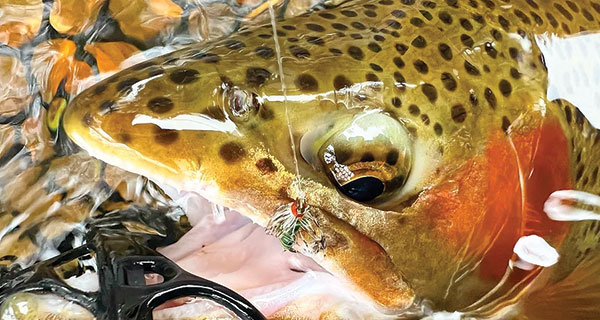Flies for effective cold weather fly fishing here in the mountains can differ in size and pattern significantly. Systematic approaches to various stream conditions can also help break the catching code. Frigid cold mornings aren’t usually a good time to be throwing dry flies, that’s for sure. Before my first cast on a winter’s day, I make sure I have my leader and fly selection tuned in for pinpoint presentations. Fishing the shortest leader possible will increase the odds of getting the fly close enough to a trout’s nose that he’ll take a swipe. It has to be long enough to reach the bottom of the pool easily and rapidly for a dredging presentation because that’s normally where the trout will be with 33-degree water. Czech nymphing is great for this. Icy water will normally have the fish’s strike zone about the size of a ping pong ball, in other words, that fly literally needs to almost bang that fish on the nose. A lot of times I’m just trying to get a reaction strike, not a feeding reaction. Fly size can range from size 6 bounced streamers to size 20 midges. I will usually start with large flies such as a Wooly Bugger or Pat’s Rubber Legs, then hopefully I’ll find the fish in the mood to eat a big bite and then work down from there. It’s a whole lot easier to land a big trout on a large sized hook than a teeny one. If that doesn’t work smaller nymphs or egg patterns or even a San Juan Worm or a squirmy might be the ticket. If I have to go even smaller, Zebra Midges or Rainbow Warriors get the nod. Swung flies such as soft hackles and small streamers or intruders can also be extremely effective in enticing a stubborn fish. A slow “static swing” as I call it, can be just too much for a trout to handle. Making the fly easy to catch and easy to eat is a good way to look at winter fishing. The river sweeping of a Spey type presentation can cover every inch of water and get that fly in the magic zone effectively.
Water conditions such as super clear clean water call for more natural looking fly patterns. When we have high or stained water, it’s time to break out the bling. Brightly colored flies, or the color white or even black, can be more easily seen by a trout. Weighted flies are easier to get down quickly and stay there. You should be getting hung up every now and then to be sure you’re deep enough. If you are snagged every cast, lighten up a bit.
The daily rise in the water temperature can fluctuate three to four degrees if the sun is shining brightly, even on a cold day. The highest winter water temperatures on a nice day will usually peak out around two pm. That will probably enlarge the trout’s strike zone too from a ping pong ball to maybe a softball, making it much easier to hit the strike zone. Be sure to be there at the time of peak activity, it may only last a couple of hours before the fish lock down. See you on the river!
Give David Hulsey a call at (770) 639-4001 to book a class or a guided trout trip. See his website at www.hulseyflyfishing.com
